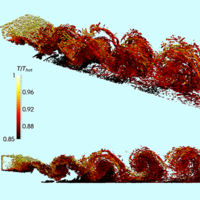当前位置:
X-MOL 学术
›
Phys. Rev. Fluids
›
论文详情
Our official English website, www.x-mol.net, welcomes your
feedback! (Note: you will need to create a separate account there.)
Large eddy simulations of wall jets with coflow for the study of turbulent Prandtl number variations and data-driven modeling
Physical Review Fluids ( IF 2.5 ) Pub Date : 2020-06-18 , DOI: 10.1103/physrevfluids.5.064501 Ali Haghiri , Richard D. Sandberg
Physical Review Fluids ( IF 2.5 ) Pub Date : 2020-06-18 , DOI: 10.1103/physrevfluids.5.064501 Ali Haghiri , Richard D. Sandberg

|
There is a continuing effort by turbulence researchers to provide improved turbulent heat flux predictions for Reynolds-averaged Navier-Stokes (RANS) calculations of heat transfer applications. In this paper, data-driven models are developed for the turbulent heat flux prediction in wall jets with coflow using a gene expression programming (GEP)–based machine-learning technique. The training data used as input to the optimization algorithm are obtained by performing highly resolved large eddy simulations (LES) of nine cases covering various flow and geometry conditions. The study examines whether predictive RANS-based heat transfer closures can be trained that are robust to these physically very different nine LES cases. The GEP heat flux closures were developed by adopting the gradient-diffusion hypothesis with the optimization target being a nondimensional parameter representing the inverse of a nonconstant turbulent Prandtl number (), with a functional dependence on the velocity and temperature gradients. First, examination of the turbulent Prandtl number calculated from time-averaged LES data showed a significant deviation from the commonly assumed constant value of 0.9, with a more significant dependence on the lip wall thickness than the blowing ratio. Second, a posteriori testing of the developed closures by solving the RANS-based scalar transport equation using as input the LES time-averaged velocity and turbulent viscosity showed a significant improvement in the prediction of adiabatic wall effectiveness not only for the cases they were trained on, but also for the entire matrix of LES cases. Finally, our best-performing model (trained on the thickest lip wall case) was also evaluated in a full RANS context and a significant improvement for the prediction of the adiabatic wall effectiveness was achieved, in particular for the medium and the thin lip thickness cases. The lack of improvement when testing the thickest lip wall case in a full RANS context indicates that for cases with strong vortex shedding the effect of organized unsteadiness on the turbulent flow field is important. In such cases, only modifying the heat flux model without improving the RANS velocity field is not sufficient and other methodologies like deriving a model for the Reynolds stress are necessary. Collectively, the current study demonstrates the ability of the presented model-development framework in creating bespoke models that can provide accurate predictions for a wide range of operating conditions.
中文翻译:

带有涡流的壁射流的大型涡流模拟,用于研究湍流普朗特数变化和数据驱动的建模
湍流研究人员一直在努力为传热应用的雷诺平均Navier-Stokes(RANS)计算提供改进的湍流热通量预测。在本文中,使用基于基因表达编程(GEP)的机器学习技术,开发了数据驱动的模型来预测带有共流的壁式射流中的湍流热通量。通过对九种情况进行高度解析的大涡模拟(LES),获得了用作优化算法输入的训练数据,这些情况涵盖了各种流动和几何条件。该研究检查了是否具有预测性可以训练基于RANS的传热密封件,这些密封件对这9个物理上非常不同的LES情况具有鲁棒性。GEP热通量闭塞是通过采用梯度扩散假设而开发的,优化目标是一个非维数参数,表示非恒定湍流普朗特数(),并且在功能上取决于速度和温度梯度。首先,根据时间平均LES数据计算得出的湍流普朗特数显示出与通常假定的常数0.9有显着偏差,并且对唇壁厚度的依赖性比吹塑比更大。二,后验使用LES时间平均速度和湍流粘度作为输入,通过求解基于RANS的标量输运方程对发达的密封件进行测试,结果显示,绝热壁效果的预测不仅在受过培训的情况下,而且在预测隔热壁效果方面均得到了显着改善LES案例的整个矩阵。最后,我们还在全RANS环境中评估了我们性能最佳的模型(在最厚的唇壁情况下进行了训练),并且在绝热壁效果的预测方面取得了显着改进,尤其是在中等和薄唇厚度的情况下。在完整的RANS环境中测试最厚的唇壁情况时,仍缺乏改进,这表明对于涡旋脱落强烈的情况,有组织的不稳定对湍流场的影响非常重要。在这种情况下 仅修改热通量模型而不改善RANS速度场是不够的,还需要其他方法,如推导雷诺应力模型。总而言之,当前的研究证明了所提出的模型开发框架在创建定制模型中的能力,该定制模型可以为各种操作条件提供准确的预测。
更新日期:2020-06-18
中文翻译:

带有涡流的壁射流的大型涡流模拟,用于研究湍流普朗特数变化和数据驱动的建模
湍流研究人员一直在努力为传热应用的雷诺平均Navier-Stokes(RANS)计算提供改进的湍流热通量预测。在本文中,使用基于基因表达编程(GEP)的机器学习技术,开发了数据驱动的模型来预测带有共流的壁式射流中的湍流热通量。通过对九种情况进行高度解析的大涡模拟(LES),获得了用作优化算法输入的训练数据,这些情况涵盖了各种流动和几何条件。该研究检查了是否具有预测性可以训练基于RANS的传热密封件,这些密封件对这9个物理上非常不同的LES情况具有鲁棒性。GEP热通量闭塞是通过采用梯度扩散假设而开发的,优化目标是一个非维数参数,表示非恒定湍流普朗特数(),并且在功能上取决于速度和温度梯度。首先,根据时间平均LES数据计算得出的湍流普朗特数显示出与通常假定的常数0.9有显着偏差,并且对唇壁厚度的依赖性比吹塑比更大。二,后验使用LES时间平均速度和湍流粘度作为输入,通过求解基于RANS的标量输运方程对发达的密封件进行测试,结果显示,绝热壁效果的预测不仅在受过培训的情况下,而且在预测隔热壁效果方面均得到了显着改善LES案例的整个矩阵。最后,我们还在全RANS环境中评估了我们性能最佳的模型(在最厚的唇壁情况下进行了训练),并且在绝热壁效果的预测方面取得了显着改进,尤其是在中等和薄唇厚度的情况下。在完整的RANS环境中测试最厚的唇壁情况时,仍缺乏改进,这表明对于涡旋脱落强烈的情况,有组织的不稳定对湍流场的影响非常重要。在这种情况下 仅修改热通量模型而不改善RANS速度场是不够的,还需要其他方法,如推导雷诺应力模型。总而言之,当前的研究证明了所提出的模型开发框架在创建定制模型中的能力,该定制模型可以为各种操作条件提供准确的预测。










































 京公网安备 11010802027423号
京公网安备 11010802027423号